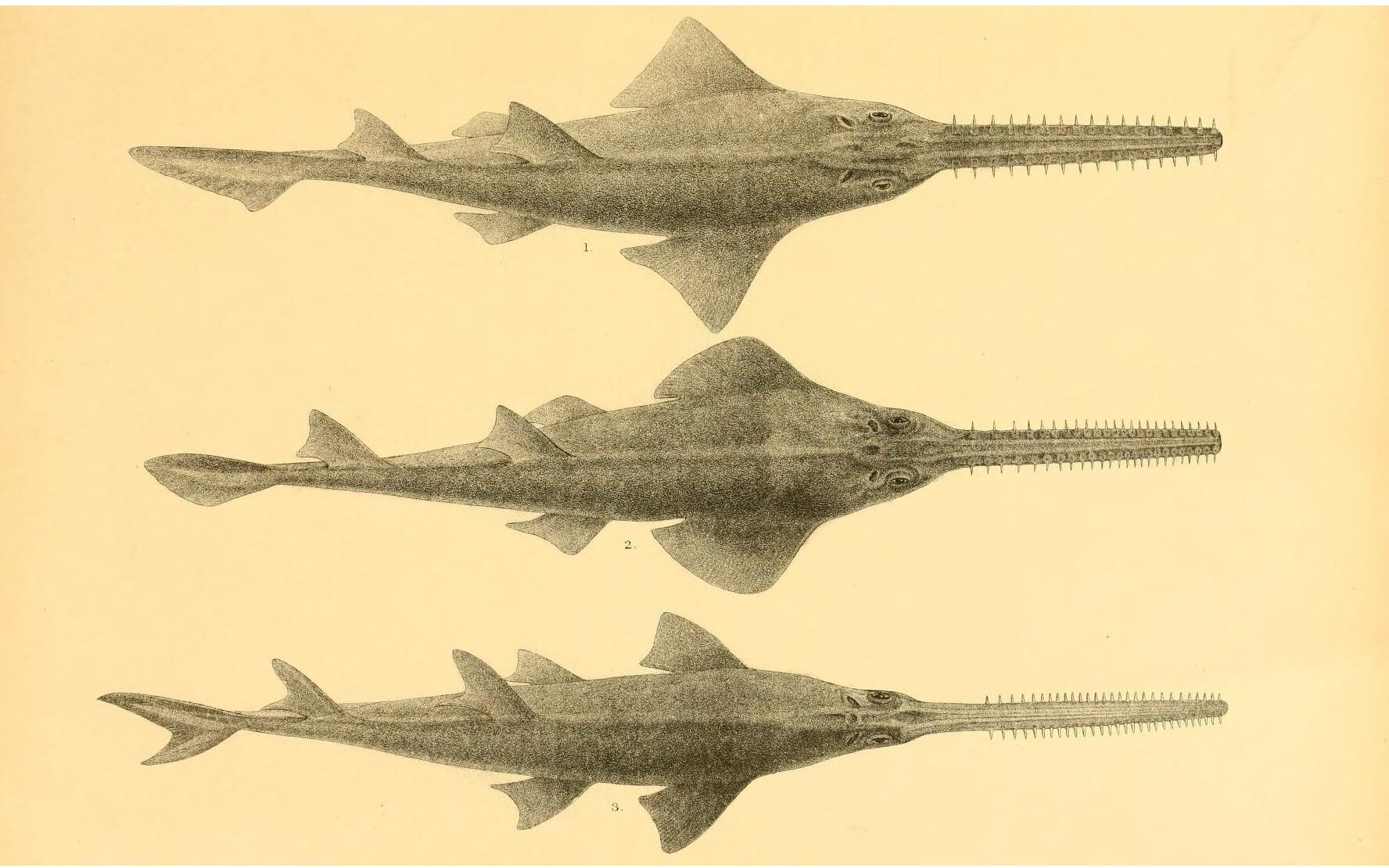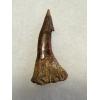This complete Onchopristis barb was found in Kem Kem, Morocco. It is 2 3/4 inches long, with a rich brown color and a lighter brown root, showcasing the incredible preservation of this ancient fish’s remains. Onchopristis, an intriguing creature from around 95 million years ago, would have been a remarkable sight in its ancient aquatic habitat.
Onchopristis is an extinct genus of sawfish that lived during the Cretaceous period, approximately 95 to 66 million years ago. These creatures were remarkable for their long, blade-like rostrums (saw-like snouts) lined with sharp teeth, which they likely used for hunting and defense in the ancient rivers and shallow seas they inhabited. Fossils of Onchopristis have been discovered in various locations around the world, including Africa, Europe, and North America, providing valuable insights into the ecology and evolution of these fascinating creatures.
The most striking feature of Onchopristis was its rostrum, which could grow up to several meters in length, making it one of the largest known sawfish species. The rostrum was covered in closely spaced teeth, resembling a saw, hence the common name “sawfish.” These teeth were not true teeth in the mammalian sense but rather specialized structures called denticles, which are modified scales. These denticles were incredibly sharp and likely played a crucial role in catching and dismembering prey.
Onchopristis was a formidable predator, using its saw-like rostrum to slash through schools of fish and other small aquatic creatures. The sawfish would then use its sharp teeth to impale and consume its prey. The shape and structure of the rostrum suggest that Onchopristis primarily fed on soft-bodied prey, such as fish and squid, although it may have also targeted larger prey on occasion.
Fossils of Onchopristis are often found in marine and freshwater sedimentary rocks, indicating that these creatures were capable of living in a variety of aquatic environments. Some fossils show evidence of abrasion and wear, suggesting that Onchopristis spent much of its time in sandy or muddy environments where the rostrum would come into contact with the substrate.
The discovery of Onchopristis fossils has provided valuable information about the evolution of sawfish and their relatives. These creatures are part of a group known as elasmobranchs, which includes modern sharks, rays, and skates. The unique morphology of Onchopristis and other sawfish species has led scientists to propose several hypotheses about the evolutionary origins of the saw-like rostrum.
One hypothesis suggests that the saw-like rostrum evolved as a specialized feeding adaptation, allowing sawfish to efficiently capture and consume prey. Another hypothesis suggests that the rostrum evolved as a defensive adaptation, helping sawfish deter predators or compete with other individuals for resources. The exact evolutionary history of the saw-like rostrum remains a topic of ongoing research and debate among paleontologists.

In addition to their ecological importance, Onchopristis fossils also provide valuable information about the paleogeography and paleoclimate of the Cretaceous period. The distribution of Onchopristis fossils around the world indicates that these creatures were widespread and inhabited a variety of aquatic environments. Studying the distribution of Onchopristis fossils can help scientists reconstruct ancient river systems and marine environments, providing insights into the geological history of the Earth.
Onchopristis fossils have been found in several regions around the world, with some of the most significant discoveries coming from Morocco. The presence of Onchopristis fossils in Morocco has provided scientists with valuable insights into the paleobiogeography of these ancient creatures and their distribution during the Cretaceous period.
Morocco is renowned for its rich fossil deposits, particularly from the Kem Kem Beds, which date back to the Late Cretaceous period, approximately 100 to 95 million years ago. The Kem Kem Beds have yielded a diverse array of fossils, including those of dinosaurs, crocodilians, turtles, and fish, providing a snapshot of the prehistoric ecosystems that once existed in this region.
Among the fossils found in the Kem Kem Beds are numerous remains of Onchopristis, including well-preserved rostra (saw-like snouts) and associated teeth. These fossils have helped scientists gain a better understanding of the morphology, ecology, and behavior of Onchopristis and its role in the ancient ecosystems of North Africa.
The discovery of Onchopristis fossils in Morocco has also shed light on the paleogeography of the region during the Cretaceous period. The presence of these fossils suggests that the area was once covered by a vast system of rivers and deltas, teeming with diverse aquatic life. The presence of Onchopristis in Morocco indicates that these ancient rivers were inhabited by large predators, such as sawfish, which played a crucial role in shaping the ecology of these ancient waterways.

Studying Onchopristis fossils from Morocco has also provided insights into the paleoclimate of the region during the Cretaceous period. The presence of these fossils in sedimentary rocks indicates that the climate was likely warm and humid, with a significant amount of rainfall supporting lush vegetation along the riverbanks. This is consistent with the broader paleoclimate reconstructions for the Cretaceous period, which suggest that the Earth was generally warmer and wetter than it is today.
In addition to their scientific importance, Onchopristis fossils from Morocco also have cultural significance. The discovery of these fossils has helped raise awareness about the rich paleontological heritage of Morocco and has contributed to the country’s growing reputation as a hotspot for fossil enthusiasts and researchers alike. Fossils from Morocco, including those of Onchopristis, are highly sought after by collectors and museums around the world, further highlighting their cultural and scientific value.
Overall, the discovery of Onchopristis fossils in Morocco has provided scientists with a wealth of information about these ancient sawfish and their ecosystems. By studying these fossils, scientists have gained valuable insights into the paleobiogeography, paleoecology, and paleoclimate of North Africa during the Cretaceous period, enhancing our understanding of the natural history of this fascinating region.
Prehistoric 101 (Learn about fossils, minerals, and meteorites)
Onchopristis: The Ancient Sawfish



















Reviews